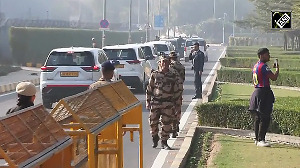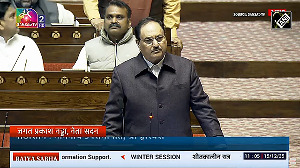The politicking came to an end, netas in Karnataka went quiet and there was this sudden gloom in political circles on Monday.
It was official, the governor had recommended the dissolution of the House and it would be President's Rule in Karnataka.
Minutes after H D Kumaraswamy resigned as the chief minister of Karnataka, the governor recommended dissolution of the House. It is learnt that the governor took the decision after he realised that no party was in any position to form the government in the state.
The day began with the Congress meeting with Governor Rameshwar Thakur and telling him that they did not intend supporting any party in the state and had no intention of forming the government.
The Congress, which had initially shown interest in aligning with the Janata Dal-Secular, backed out after a few of its leaders threatened a revolt if there was any truck with the JD-S, the party which had ditched them 20 months back.
Shortly after the meeting of the Congress, Kumaraswamy met with the governor after he had been summoned to explain his stand.
Kumaraswamy had got the governor's summons after the Bharatiya Janata Party had withdrawn support and the JD-S reduced to a minority.
During the meeting, the governor had advised him to put in his papers after Kumaraswamy told him that he did not have the numbers on the floor of the House.
Immediately after the meeting, the BJP sprung back into action and said there was a possibility of them forming the government.
The BJP and the JD-S had come to an understanding and it was agreed that B S Yediyurappa, the BJP leader would be made the chief minister of the state.
The BJP and the JD-S made all efforts to come back into power, but it was too late as the governor had already made up its mind.
The efforts by both parties were so immense that they had even decided to parade their legislators before the governor.
The chief minister who was to resign at 6.30 pm even postponed it by an hour.
Minutes before the stage was set, both parties were advised to first seek the opinion of the governor before making any move.
The BJP in New Delhi too did not show much interest in this re-alignment as it felt that there could be more problems in the future.
A delegation of the Congress, which got a whiff of this development, also urged the governor not to entertain any request by both the JD-S and the BJP to form the government.
By around 7.30 pm, Kumaraswamy met with the governor and handed over his papers.
According to reports, Kumaraswamy had suggested in the letter that the two parties could team up again to form the government.
However, by now it was too late for any damage control exercise as the governor had already made up his mind.
For the governor it was a busy day in the office. Barely two months into the job as governor of Karnataka, Rameshwar Thakur was caught up in hectic activity with various leaders meeting him.
Thakur was brought in by the United Progressive Alliance government on August 21.
Thakur who was governor of Orrisa replaced T N Chathurvedi who had been appointed by the National Democratic Alliance government.
The governor had waited and watched all the political activity that took place in the state since the beginning of October.
According to the agreement entered into by the JD-S and the BJP, the former was to hand over power to the latter at the end of 20 months.
However on October 3, the day power was to be handed over, the JD-S decided against it, following which the state was plunged into a political crisis.
The governor, however, weighed his options clearly before recommending the dissolution of the House.
Political experts said that the BJP had acted in haste and the JD-S too late.
The experts also say that Congress played its cards very carefully and stepped up the ante for the imposition of President's Rule in the state.
The governor also took into consideration a strange situation that existed in Karnataka politics.
The top three parties -- BJP, Congress and the JD-S -- had all enjoyed power in the state.
First it was the JD(S)-Congress combine and then the JD(S)-BJP combine.
Interestingly, the JD(S) which stands third on the table enjoyed power twice.
With all these factors, the governor thought that enough was enough and decided that it was best to dissolve the House.
With this decision came the end of political uncertainty and an eventful one week in Karnataka politics.





